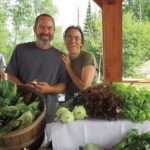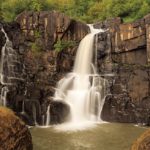Most of us have gathered wild foods at one point or another; if you’ve ever picked a fresh berry on a hot summer hike, then you’ve harvested wild food. But for some, going deeper into the world of foraging is both a great way to add new plants to your diet and to learn more about the earth around us.
Ian Andrus is a Cook County resident and experienced forager. He teaches foraging classes at North House Folk School, and he and his wife Rachel own and operate Creaking Tree Farm, and has long been interested in the challenge of collecting edible food.
“It’s actually tough to find edibles in this area,” Andrus said. “I grew up an hour west of the Twin Cities and there was so much you could find outside. I moved here 12 years ago and have learned that edible foods are out there, but they’re fewer and far between.”
For beginners, the idea of going into the woods to find edible foods may seem challenging, but Andrus offered a few tips to get started. First, a key thing to understand is that the seasonality of any wild edible follows the growth of the plant, from greens to fruits and then to roots, and it’s often easiest to identify plants during the flowering stage. A good field guide and an edibles guidebook for your region are musts, and it can be helpful to take a class or to go with someone more experienced.
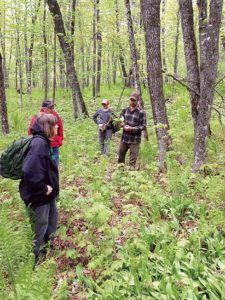
“You have to become a student of all plants,” Andrus said. “It’s hard to jump in and only learn about the edible ones. Get familiar with botanical names and the different parts of plants which might be referenced when you read a field guide.”
Andrus said that beginners shouldn’t try to learn everything at once—start with three or five plants you want to identify until you get comfortable with those and go from there. And when sampling new plants, try them one at a time—if you have a reaction to something, it’s easiest to pinpoint any intolerances that way. Finally, before going out, take some time to learn about harvesting ethics.
“Some people go a bit crazy and try to over-harvest or even sell what they find, which is not what you want to do,” Andrus said. “Make sure you understand the broader picture of what you’re harvesting—is it widespread or hard to find? Is it fast-growing or slow-growing? Those are the questions you should be asking.”
Part of understanding the broader picture, too, is appreciating the rich history of harvesting wild foods in this region. Foods that can be gathered here have been gathered by the Anishinaabe for generations and good ethics will help keep these plants around for generations to come. (Also note that while many edibles can be harvested in small amounts for personal use in Minnesota, some—such as wild rice—require a permit, and some locations may be protected. Always check your local rules and regulations before you go.)
But for those who are interested in giving foraging a try, here are some of the foods that can be found throughout the year:
Spring
In early spring, one of the first sources of food from the land comes from tree sap. Sap starts running in maple trees when daytime temperatures reach above freezing but nighttime temperatures dip below freezing, usually around mid-March to mid-April, though that can vary. Several regions of the North Shore contain large stands of maple trees and even some commercial syruping operations. It takes about 40 gallons of maple sap to make one gallon of syrup, and only trees larger than 10” diameter should be tapped. The Minnesota DNR has an online guide on how to collect sap and make syrup at home.
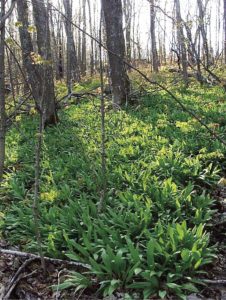
While the maple syruping season gets most of the attention, birch trees can also be tapped for sap. Birch sap typically starts running after the maple season ends. While its lower sugar content makes it less ideal for turning into a syrup—it takes over 100 gallons of birch sap to make birch syrup—some people enjoy drinking the sap, or “birch water” straight from the tree.
As the earth continues to warm, plants start emerging and growing leaves. Ferns are abundant throughout the region, and the fiddleheads can be harvested while they are still curled. Wild leeks can also be found, though they can be hard to find and are susceptible to overharvesting.
“If you find wild leeks, cut them a little bit above the bulb. The whole leaf has the same flavor, and keeping the bulb helps alleviate the regeneration pressure,” Andrus said.
Some other edible spring foods include dandelions, spring beauties and curly dock leaves.
Summer
As spring moves to summer, plants move from sending up greens to producing flowers and fruit. Surprisingly, early summer can be a challenging time for foraging.
“Sam Thayer has written some of the best books on wild edibles,” Andrus said. “I went on a foraging hike with him and learned that early summer was a potential starvation point if you’re not finding fish, since it’s between greens season and berry season. Game is also easier to track and trap in the winter than it is in the summer.”
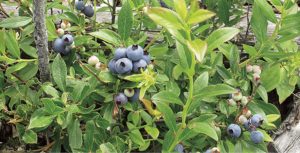
However, once July rolls around, berries become abundant. The North Shore is home to many edible berries such as raspberries, blueberries and thimbleberries. Wild raspberries produce fruit that looks just like a smaller version of the raspberries you would find in a grocery store. Raspberry bushes prefer sun and grow in recently cleared areas and along the forest edges. Their leaves can also be used for tea. Blueberries can also be found in clearings and on rocky hilltops. They grow on small shrubs and can do well in areas previously burned by wildfire, such as parts of the Gunflint Trail. Thimbleberries are bright red and look similar to raspberries. They grow on plants with wide leaves of five lobes.
Autumn
As summer begins to relax into autumn, foragers can find hazelnuts throughout the Northland. Beaked hazelnut is the more common variety in the Arrowhead region, and their shade-loving shrubs produce green husks, inside of which the hazelnuts can be found.
Late summer and early autumn are also when wild rice can be harvested. Permitting for wild rice runs from August 15 through September 30, though harvesting is only allowed when wild rice has ripened, usually in September. Wild rice stands are usually accessed by canoe and harvesters use flails to tap the grain into the canoe while preserving the plants. Be sure to check the Minnesota DNR website for more information about permits and other regulations surrounding wild rice harvesting.
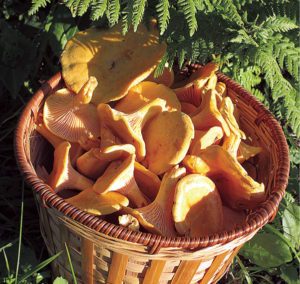
Late summer and early autumn also bring an abundance of fungi to the Northland, and recent years have seen a surge in fungi interest. Varieties include chanterelles, king boletes and lobster mushrooms. (Only eat fungi that you have confidently identified, as some regional mushrooms can make you ill or can even be poisonous.)
Rose hips, which form after rose pollination, can also be found in the late summer and into the fall. Rose hips are an excellent source of vitamin C and can be made into syrups, jellies or tea.
Winter
As you may have guessed, winter is a scant time for edible plants in the Northland, but some evergreen needles can be used for teas—pine, spruce and cedar needles can be all be steeped in hot water to make tea. Enjoy the warming beverage and vitamin C boost while waiting for spring to return.




